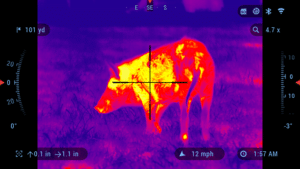In Night Vision (1) we started discussing night vision. We’ll continue that now, as there are a lot of threats you may run into that require even more sophisticated equipment than just Night Infrared (IR). Or as Bela Lugosi remarked as Count Dracula: “Listen to them, the children of the night. What music they make!”
Today it’s all about detecting HEAT through Thermal Imaging. All objects absorb, reflect, and sometimes transmit energy at different levels. Different materials give off heat or cold energy at different rates. Thermal imaging devices detect small differences in heat; they do not require visible light to produce an image, so can be used day and night (unless the manufacturer says not to in daylight.) Mammals generate heat; birds and reptiles absorb heat, so all are often warmer than their surroundings, and can be detected at greater distances with thermal imaging than with basic night vision. Cars, trucks, and boats generate heat. With thermals, you see engines and exhaust pipes brightest, because they are the hottest; if a car has been outside on a sunny day, the hood and roof will stick out. Tires and brakes are often warm from friction.
Thermal devices often have a switch that in one position the warm/hot image is bright white, and the surrounding is dark, or the picture is reversed, and the warm/hot image is black. You may have a third option of color where objects are in red, orange, and purple tones. Different targets show up best in certain options for me, so try and get one with all three, because we all see differently.
The more you play with thermal sights, the better you’ll understand what you are seeing (i.e., a mammal’s chest has more heat than its ears or tail.) Thermal sights often have zoom magnification, but sometimes at higher magnification the image blurs a bit; you’ll figure out the right power by using it.
Sixty years ago, U.S. Army scientist John Johnson developed a system to evaluate thermal sight capabilities by three measurements:
Detection: detecting whether an object is present. Usually expressed in yards or meters (for our purposes meters and yards are about the same.) “Something is there, and it bears watching” is my equivalent. The better the device, the further this is and can approach 3,000 yards.
Recognition: recognizing which class an object belongs to, such as a house, boat, truck, animal, or man. This will be less than detection range. In a 3,000 yard detection range device, recognition range may be 1,300 yards.
Identification: identifying descriptive details of the object, whether a vehicle is a car, Jeep, pickup or minivan. With practice, for a human, you can often determine number of men, if they appear in uniform, and if they appear to be holding rifles. In our 3,000 yard detection range example, identification range may be 700 yards.
For some excellent info on thermals, go to www.atncorp.com.
Now it’s time to answer your first question: what do you want this thermal device to do? Hunting feral hogs or vermin on a farm? Detecting would-be criminals? Detecting heat leaks in buildings? Power line maintenance technicians locate overheating joints, and sometimes faulty electrical wiring. Firefighters use thermals to see through smoke, find people and localize fire hotspots. They are also common tools used by many home inspectors; even home-buyers are realizing that thermals can save them thousands later.
Will you be stationary in your activity or moving? A thermal sight can get bulky; if you are stationary, that is less of an issue. What is your climate? Rain and heavy fog can severely limit the range of thermal imaging because light scatters off of droplets of water.
Since we are often looking at $1,500-$4,500 for a thermal device (sometimes more), we need an acquisition strategy. If you need more than a night sight (IR), delaying thermal a little bit may allow you to buy a better capability later. And consider buying both night vision (IR), and thermal from the same manufacturer, so accessories will almost always fit both. For a thermal sight there is one more consideration. Find a legitimate business use for the thermal. Then toward the end of the year determine if the tax break of the thermal is more advantageous this year or whether you should buy it early next year.
Either way, remember In regione caecorum rex est luscus. With a thermal sight, you will be able to see an enemy at night much, much better than he will be able to see you, if he can see you at all. Let him be the blind man.
